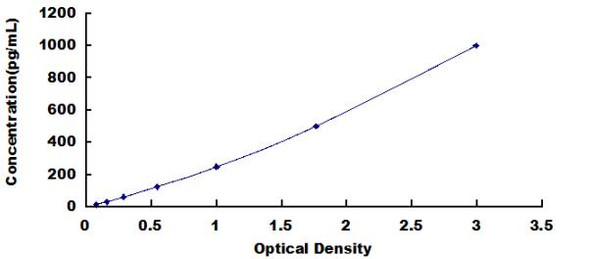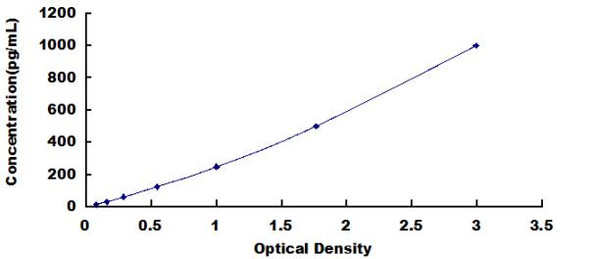Human Immunology ELISA Kits 1
Human MCSF (Macrophage Colony Stimulating Factor 1) ELISA Kit (HUES01383)
- SKU:
- HUES01383
- Product Type:
- ELISA Kit
- Size:
- 96 Assays
- Uniprot:
- P09603
- Sensitivity:
- 18.75pg/mL
- Range:
- 31.25-2000pg/mL
- ELISA Type:
- Sandwich
- Synonyms:
- M-CSF, CSF1, CSF-1
- Reactivity:
- Human
- Sample Type:
- Serum, plasma and other biological fluids
- Research Area:
- Immunology
Description
| Assay type: | Sandwich |
| Format: | 96T |
| Assay time: | 4.5h |
| Reactivity: | Human |
| Detection Method: | Colormetric |
| Detection Range: | 31.25-2000 pg/mL |
| Sensitivity: | 18.75 pg/mL |
| Sample Volume Required Per Well: | 100µL |
| Sample Type: | Serum, plasma and other biological fluids |
| Specificity: | This kit recognizes Human MCSF in samples. No significant cross-reactivity or interference between Human MCSF and analogues was observed. |
This ELISA kit uses Sandwich-ELISA as the method. The micro ELISA plate provided in this kit has been pre-coated with an antibody specific to Human MCSF. Standards or samples are added to the appropriate micro ELISA plate wells and combined with the specific antibody. Then a biotinylated detection antibody specific for Human MCSF and Avidin-Horseradish Peroxidase (HRP) conjugate are added to each micro plate well successively and incubated. Free components are washed away. The substrate solution is added to each well. Only those wells that contain Human MCSF, biotinylated detection antibody and Avidin-HRP conjugate will appear blue in color. The enzyme-substrate reaction is terminated by adding Stop Solution and the color turns yellow. The optical density (OD) is measured spectrophotometrically at a wavelength of 450 nm ± 2 nm. The OD value is proportional to the concentration of Human MCSF. The concentration of Human MCSF in samples can be calculated by comparing the OD of the samples to the standard curve.
| UniProt Protein Function: | M-CSF: Cytokine that plays an essential role in the regulation of survival, proliferation and differentiation of hematopoietic precursor cells, especially mononuclear phagocytes, such as macrophages and monocytes. Promotes the release of proinflammatory chemokines, and thereby plays an important role in innate immunity and in inflammatory processes. Plays an important role in the regulation of osteoclast proliferation and differentiation, the regulation of bone resorption, and is required for normal bone development. Required for normal male and female fertility. Promotes reorganization of the actin cytoskeleton, regulates formation of membrane ruffles, cell adhesion and cell migration. Plays a role in lipoprotein clearance. Aberrant expression of CSF1 or CSF1R can promote cancer cell proliferation, invasion and formation of metastases. Overexpression of CSF1 or CSF1R is observed in a significant percentage of breast, ovarian, prostate, and endometrial cancers. Aberrant expression of CSF1 or CSF1R may play a role in inflammatory diseases, such as rheumatoid arthritis, glomerulonephritis, atherosclerosis, and allograft rejection. 3 isoforms of the human protein are produced by alternative splicing. |
| UniProt Protein Details: | Protein type:Cytokine; Membrane protein, integral Chromosomal Location of Human Ortholog: 1p13. 3 Cellular Component: extracellular space; perinuclear region of cytoplasm Molecular Function:cytokine activity; growth factor activity; macrophage colony stimulating factor receptor binding; protein binding; protein homodimerization activity Biological Process: macrophage differentiation; osteoclast differentiation; positive regulation of cell migration; positive regulation of cell proliferation; positive regulation of cell-matrix adhesion; positive regulation of cellular protein metabolic process; positive regulation of macrophage differentiation; positive regulation of monocyte differentiation; positive regulation of mononuclear cell proliferation; positive regulation of osteoclast differentiation; positive regulation of protein kinase activity; reproductive developmental process; transmembrane receptor protein tyrosine kinase signaling pathway |
| NCBI Summary: | The protein encoded by this gene is a cytokine that controls the production, differentiation, and function of macrophages. The active form of the protein is found extracellularly as a disulfide-linked homodimer, and is thought to be produced by proteolytic cleavage of membrane-bound precursors. The encoded protein may be involved in development of the placenta. Alternate splicing results in multiple transcript variants. [provided by RefSeq, Sep 2011] |
| UniProt Code: | P09603 |
| NCBI GenInfo Identifier: | 311033367 |
| NCBI Gene ID: | 1435 |
| NCBI Accession: | P09603. 2 |
| UniProt Secondary Accession: | P09603,Q13130, Q14086, Q14806, Q5VVF3, Q5VVF4, Q9UQR8 A8K6J5, |
| UniProt Related Accession: | P09603 |
| Molecular Weight: | 29,215 Da |
| NCBI Full Name: | Macrophage colony-stimulating factor 1 |
| NCBI Synonym Full Names: | colony stimulating factor 1 |
| NCBI Official Symbol: | CSF1 |
| NCBI Official Synonym Symbols: | MCSF; CSF-1 |
| NCBI Protein Information: | macrophage colony-stimulating factor 1 |
| UniProt Protein Name: | Macrophage colony-stimulating factor 1 |
| UniProt Synonym Protein Names: | Lanimostim |
| Protein Family: | Macrophage colony-stimulating factor |
| UniProt Gene Name: | CSF1 |
| UniProt Entry Name: | CSF1_HUMAN |
As the OD values of the standard curve may vary according to the conditions of the actual assay performance (e. g. operator, pipetting technique, washing technique or temperature effects), the operator should establish a standard curve for each test. Typical standard curve and data is provided below for reference only.
| Concentration (pg/mL) | O.D | Average | Corrected |
| 2000 | 2.451 2.475 | 2.463 | 2.403 |
| 1000 | 1.577 1.577 | 1.577 | 1.517 |
| 500 | 0.969 0.959 | 0.964 | 0.904 |
| 250 | 0.469 0.473 | 0.471 | 0.411 |
| 125 | 0.242 0.23 | 0.236 | 0.176 |
| 62.5 | 0.161 0.159 | 0.16 | 0.1 |
| 31.25 | 0.108 0.116 | 0.112 | 0.052 |
| 0 | 0.054 0.066 | 0.06 | -- |
Precision
Intra-assay Precision (Precision within an assay): 3 samples with low, mid range and high level Human MCSF were tested 20 times on one plate, respectively.
Inter-assay Precision (Precision between assays): 3 samples with low, mid range and high level Human MCSF were tested on 3 different plates, 20 replicates in each plate.
| Intra-assay Precision | Inter-assay Precision | |||||
| Sample | 1 | 2 | 3 | 1 | 2 | 3 |
| n | 20 | 20 | 20 | 20 | 20 | 20 |
| Mean (pg/mL) | 94.07 | 270.27 | 679.52 | 100.99 | 263.75 | 714.11 |
| Standard deviation | 5.21 | 12.19 | 35.74 | 5.59 | 11.34 | 31.85 |
| C V (%) | 5.54 | 4.51 | 5.26 | 5.54 | 4.30 | 4.46 |
Recovery
The recovery of Human MCSF spiked at three different levels in samples throughout the range of the assay was evaluated in various matrices.
| Sample Type | Range (%) | Average Recovery (%) |
| Serum (n=5) | 85-96 | 91 |
| EDTA plasma (n=5) | 85-98 | 90 |
| Cell culture media (n=5) | 85-97 | 92 |
Linearity
Samples were spiked with high concentrations of Human MCSF and diluted with Reference Standard & Sample Diluent to produce samples with values within the range of the assay.
| Serum (n=5) | EDTA plasma (n=5) | Cell culture media (n=5) | ||
| 1:2 | Range (%) | 86-101 | 90-107 | 85-97 |
| Average (%) | 92 | 97 | 92 | |
| 1:4 | Range (%) | 88-102 | 85-100 | 84-98 |
| Average (%) | 94 | 92 | 90 | |
| 1:8 | Range (%) | 91-107 | 84-94 | 84-96 |
| Average (%) | 98 | 89 | 89 | |
| 1:16 | Range (%) | 89-104 | 82-93 | 82-94 |
| Average (%) | 96 | 88 | 89 |
An unopened kit can be stored at 4°C for 1 month. If the kit is not used within 1 month, store the items separately according to the following conditions once the kit is received.
| Item | Specifications | Storage |
| Micro ELISA Plate(Dismountable) | 8 wells ×12 strips | -20°C, 6 months |
| Reference Standard | 2 vials | |
| Concentrated Biotinylated Detection Ab (100×) | 1 vial, 120 µL | |
| Concentrated HRP Conjugate (100×) | 1 vial, 120 µL | -20°C(shading light), 6 months |
| Reference Standard & Sample Diluent | 1 vial, 20 mL | 4°C, 6 months |
| Biotinylated Detection Ab Diluent | 1 vial, 14 mL | |
| HRP Conjugate Diluent | 1 vial, 14 mL | |
| Concentrated Wash Buffer (25×) | 1 vial, 30 mL | |
| Substrate Reagent | 1 vial, 10 mL | 4°C(shading light) |
| Stop Solution | 1 vial, 10 mL | 4°C |
| Plate Sealer | 5 pieces | |
| Product Description | 1 copy | |
| Certificate of Analysis | 1 copy |
- Set standard, test sample and control (zero) wells on the pre-coated plate and record theirpositions. It is recommended to measure each standard and sample in duplicate. Note: addall solutions to the bottom of the plate wells while avoiding contact with the well walls. Ensuresolutions do not foam when adding to the wells.
- Aliquot 100 µL of standard solutions into the standard wells.
- Add 100 µL of Sample / Standard dilution buffer into the control (zero) well.
- Add 100 µL of properly diluted sample (serum, plasma, tissue homogenates and otherbiological fluids) into test sample wells.
- Cover the plate with the sealer provided in the kit and incubate for 90 min at 37 °C.
- Aspirate the liquid from each well, do not wash. Immediately add 100 µL of BiotinylatedDetection Ab working solution to each well. Cover the plate with a plate seal and gently mix. Incubate for 1 hour at 37 °C.
- Aspirate or decant the solution from the plate and add 350 µL of wash buffer to each welland incubate for 1-2 minutes at room temperature. Aspirate the solution from each well andclap the plate on absorbent filter paper to dry. Repeat this process 3 times. Note: a microplatewasher can be used in this step and other wash steps.
- Add 100 µL of HRP Conjugate working solution to each well. Cover with a plate seal andincubate for 30 min at 37 °C.
- Aspirate or decant the solution from each well. Repeat the wash process for five times asconducted in step 7.
- Add 90 µL of Substrate Reagent to each well. Cover with a new plate seal and incubate forapproximately 15 min at 37 °C. Protect the plate from light. Note: the reaction time can beshortened or extended according to the actual color change, but not by more than 30min.
- Add 50 µL of Stop Solution to each well. Note: Adding the stop solution should be done inthe same order as the substrate solution.
- Determine the optical density (OD value) of each well immediately with a microplate readerset at 450 nm.






